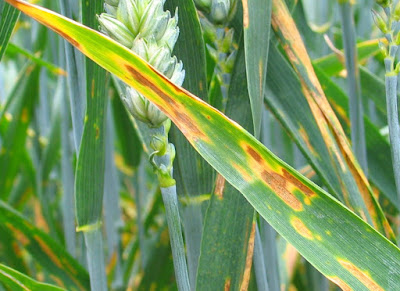 |
| Objectives, Scope, Concept and Causes of Plant Diseases. https://cststudy.blogspot.com |
https://agriculturistmusa.com/causes-of-plant-diseases-and-concept-of-plant-pathology/
After transferring all post into new site, this site will be shutdown.
Objectives of Plant Pathology
Plant
Pathology (Phytopathology) deals with the cause, etiology, resulting losses and
control or management of the plant diseases. The objectives of the Plant
Pathology are the study on: i. the
living entities that cause diseases in plants; ii. the non-living entities and
the environmental conditions that cause disorders in plants; iii. the
mechanisms by which the disease causing agents produce diseases; iv. the
interactions between the disease causing agents and host plant in relation to
overall environment; and v. the method
of preventing or management the diseases and reducing the losses/damages caused
by diseases.
Scope of Plant Pathology
Plant
pathology comprises with the basic knowledge and technologies of Botany, Plant
Anatomy, Plant Physiology, Mycology, Bacteriology, Virology, Nematology,
Genetics, Molecular Biology, Genetic Engineering, Biochemistry, Horticulture,
Tissue Culture, Soil Science, Forestry, Physics, Chemistry, Meteorology,
Statistics and many other branches of applied science.
Concept of Plant Disease
The normal
physiological functions of plants are disturbed when they are affected by
pathogenic living organisms or by some environmental factors. Initially plants
react to the disease causing agents, particularly in the site of infection.
Later, the reaction becomes more widespread and histological changes take
place. Such changes are expressed as different types of symptoms of the disease
which can be visualized macroscopically. As a result of the disease, plant
growth in reduced, deformed or even the plant dies.
When a plant
is suffering, we call it diseased, i.e. it is at ‘dis-ease’. Disease is a
condition that occurs in consequence of abnormal changes in the form,
physiology, integrity or behaviour of the plant.
According to American
Phytopathological Society (Phytopathology 30:361-368, 1940), disease is a
deviation from normal functioning of physiological processes of sufficient
duration or intensity to cause disturbance or cessation of vital activities.
The British Mycological Society (Trans. Brit. Mycol. Soc. 33:154-160, 1950)
defined the disease as a harmful deviation from the normal functioning of
process. Recently, Encyclopedia Britannica (2002) forwarded a simplified
definition of plant disease. A plant is diseased when it is continuously disturbed
by some causal agent that results in abnormal physiological process that
disrupts the plants normal structure, growth, function or other activities.
This interference with one or more plant’s essential physiological or
biochemical systems elicites characteristic pathological conditions or
symptoms.
Causes of Plant Diseases
Plant
diseases are caused by pathogens. Hence a pathogen is always associated with a
disease. In other way, disease is a symptom caused by the invasion of a
pathogen that is able to survive, perpetuate and spread. Further, the word
“pathogen” can be broadly defined as any agent or factor that incites 'pathos
or disease in an organism or host. In strict sense, the causes of plant
diseases are grouped under following categories:
1. Animate or biotic causes: Pathogens of living nature are
categorized into the following groups.
(i)
Fungi
(v) Algae
(ii)
Bacteria
(vi)
Phanerogams
(iii)
Phytoplasma
(vii)
Protozoa
(iv)
Rickettsia-like organisms
(viii)
Nematodes
2. Mesobiotic causes :
These
disease incitants are neither living or non-living, e.g. (i) Viruses
(ii) Viroides
3. Inanimate or abiotic causes: In true sense these factors cause
damages (any reduction in the quality or quantity of yield or loss of revenue)
to the plants rather than causing disease. The causes are:
(i)
Deficiencies or excess of nutrients(e.g.‘Khaira’ disease of rice due to Zn
deficiency)
(ii) Light
(iii)
Moisture
(iv) Temperature
(v) Air
pollutants (e.g. black tip of mango)
(vi) Lack of
oxygen (e.g. hollow and black heart of potato)
(vii) Toxicity of pesticides
(viii)
Improper cultural practices
(ix)
Abnormality in soil conditions (acidity, alkalinity)
Comments
Post a Comment